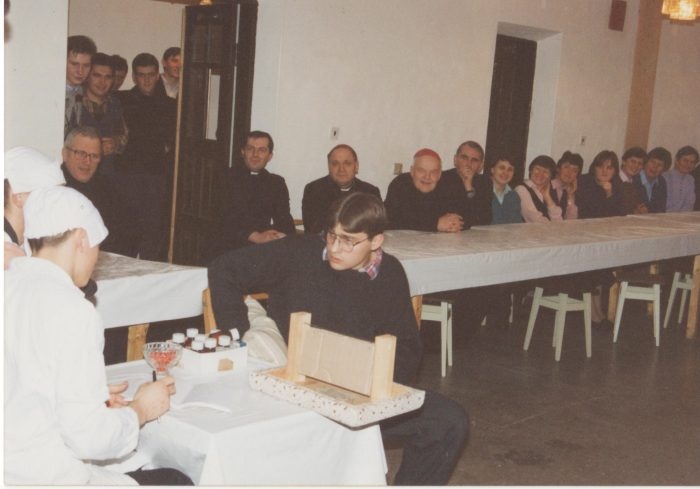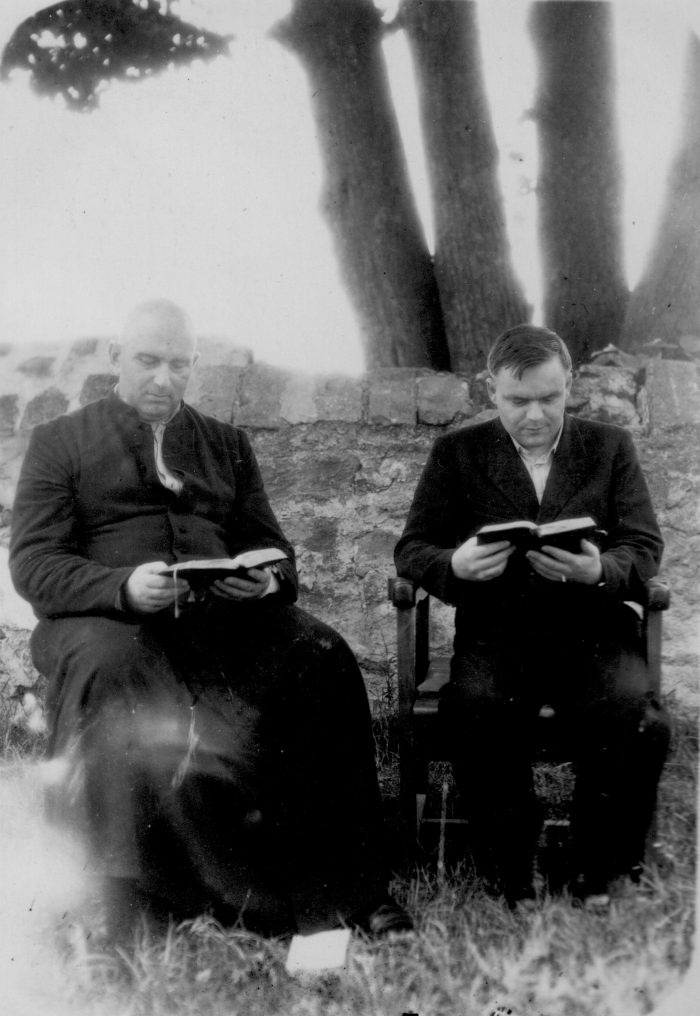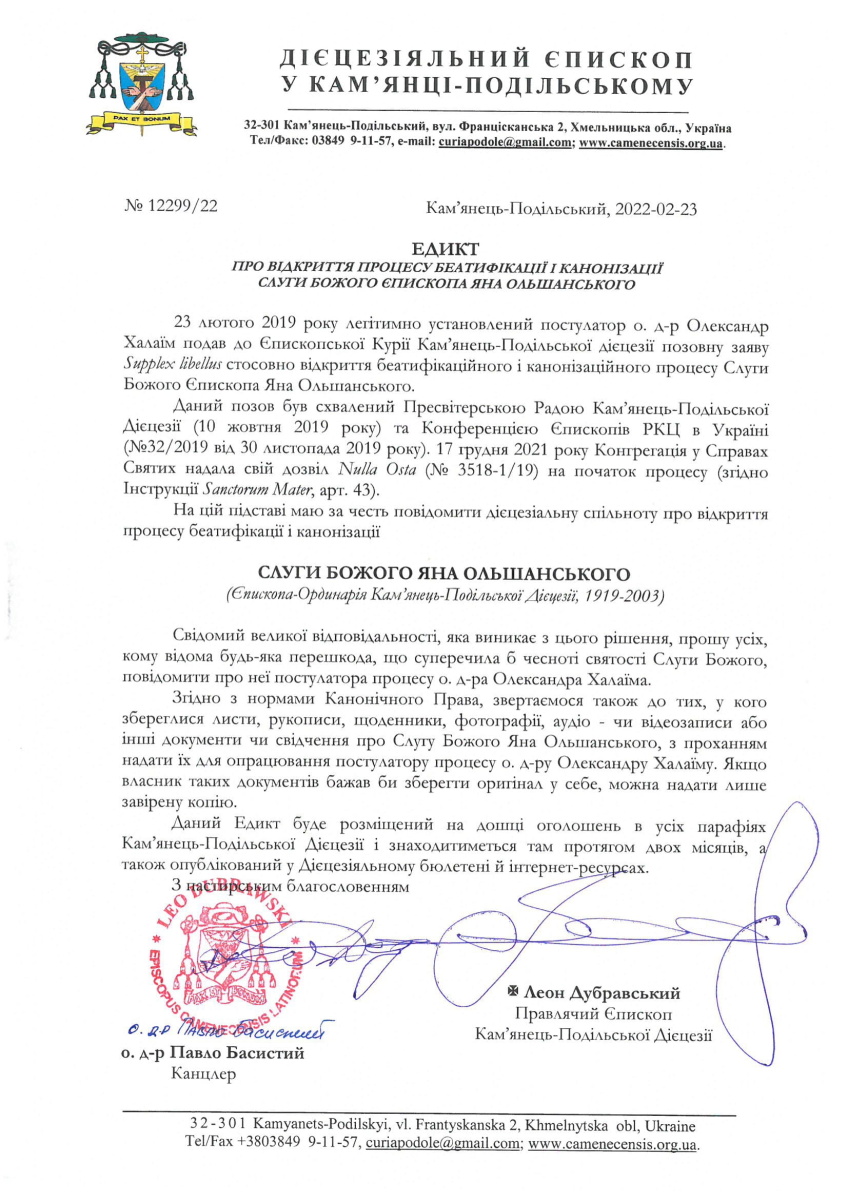On February 23, the opening of the beatification process of Bishop Jan Olszanki, a member of the Congregation of Marian Fathers, was officially announced in the Kamieniec cathedral. Most of his sixty-year priestly ministry occurred during the period of communist persecution and repression and he remains in the memory of his fellow Catholics and countrymen a tireless defender of the Polish community and the faith of the Roman Catholic Church in Ukraine.
Bishop Jan Olszański was born on January 14, 1919, in the town of Hucisko, in the district of Brody, Poland (present-day Ukraine). In 1938, he graduated from the gymnasium in Brody. In the same year, he entered the seminary in Lviv, graduating in 1942. After receiving his priestly ordination that same year, he worked in the village of Kaczanówka. Later, the Archbishop of Lviv, Bolesław Twardowski, appointed Fr. Olszański the administrator of the parish in Gródek Podolski,at the same time entrusting to him pastoral care of several neighboring parishes.
After Ukraine was incorporated into the Soviet Union, Fr. Jan Olszański moved to Lviv, where he performed his priestly duties as vicar in the cathedral and also at the Church of Our Lady of the Snows. After two years in Lviv, he returned to Gródek in Podolia, where he worked until 1959 when the communist authorities forbade him from carrying out his pastoral work. According to the accounts of witnesses, he traveled to the parishes entrusted to him disguised as a woman in order to be able to hear the confessions of the faithful. After a short period of time, the authorities lifted their restrictions on his pastoral work and he was permitted to continue his work publicly, this time in the remote village of Manikowce, where he worked until 1991. As one of the few Catholic priests in the area, he tried to provide pastoral care to the faithful in his territory, covering almost half of today’s Kamieniec-Podolski Diocese,at the risk of his possible deportation or execution.
For thirty-two years, from 1959 to 1991, Jan Olszański was an ordinary parish priest. Fr. Jan did not leave the Podole region, even though he had the opportunity to return to his home diocese. Manikowce became his escape – a small village in the Chmielnik region, where, “you did not wait for the parish priest or know what to do with him”, as Stanisław Nahorniak recalls. However, he was an extraordinary pastor because hundreds of people came to Manikowiec to confess, receive the Sacraments and hear the Word of God. In these difficult times, Fr.Jan understood well that the future of the Church lies in children and young people. He prepared them for the Sacraments, taught prayer, led Adoration, and even helped teach mathematics. His pockets were always full of sweets for the children in his Catechism classes and despite the hardships he endured and the difficulty of the times, he never complained, but prayed and worked for his parishioners.
A local government authority, tasked with overseeing religious figures in the area, once reported the following about Fr. Jan: “He is a religious fanatic; he stood in the chapel every morning and evening and prayed. In the rented apartment in Gródek, where he lived, there was no radio, he did not subscribe to newspapers, and he only read religious literature. One time when he came to an attorney’s office, waiting for a summons, he was reading a prayer book. He stays in seclusion, tries not to meet anyone, and strictly follows religious canons. By his example, he educates religious activists.”
In 1987, he entered the Congregation of Marian Fathers and in 1988 made his first vows. In 1990, he became the first Superior of the Ukrainian Vicariate, and in 1991 Pope St. John Paul II appointed Fr. Jan Olszański bishop and ordinary of the recently-restored Diocese of Kamieniec-Podolski. Witnesses say that he did not want to be a bishop: “Four times the representatives of the Nunciature came to Manikowce and talked with him for almost four hours.” He did not want to be a bishop; after all, he considered himself unworthy of such a high position.He was ordained bishop at the age of seventy-two when most other people usually think about retirement.
The Pope entrusted to his care the faithful living in eight administrative districts in the southern part of Ukraine. The Kamieniec-Podolski Diocese was then, territorially speaking, exceptionally extensive. Before the division of 2002, it included the following oblasts: Vinnytsia, Khmelnytsky, Odessa, Zaporizhia, Kharkiv, Dnipropetrovsk, Donetsk, Luhansk, Poltavsky, Mikolajowski, Kherson, Kirovograd and AR Krym. Thanks to his efforts, many pastoral centers and parishes were created, which later became the basis for the creation of two new dioceses. People said that he always prayed the rosary and that “always” should be taken literally. Those who traveled with Bishop Jan said: “When we were in the car, he prayed the rosary all the time, endlessly; once we had finished, we started up again “. As bishop, heestablished a major seminary in Gródek Podolski and reopened over 200 parishes. On May 4, 2002, Pope John Paul II, at the bishop’s own request, released him from his duties as diocesan ordinary.
He performed his duties as bishop of the Kamieniec-Podolski Diocese for eleven years. On February 23, 2022, nineteen years will have passed since his death, the death of the first shepherd of the Kamieniec-Podolski Diocese after the restoration of the hierarchy of the Roman Catholic Church in Ukraine. It is on this day, on the anniversary of his passing to the Lord, that the Church in Kamieniec will officially begin the beatification process of Bishop Jan Olszański, a priest of the Marian Fathers.
















